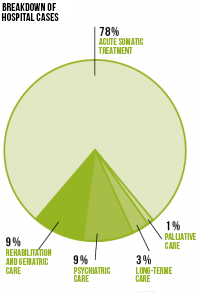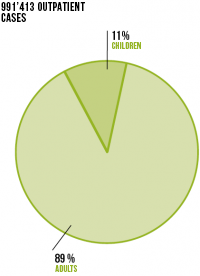
We need to distinguish between inpatient activity, measured in number of hospitalisations, and outpatient activity, measured in the number of patients supported, hospital visits or day cases.
Stability of inpatient activity
In 2015, the HUG counted 59,430 hospital stays vs. 58,952 in 2014. This apparent stability belies an increase in activity resulting from the growth in the population of the canton of Geneva, offset by transfers of activity to outpatient care.
A rise in acute care
The change in activity differs between areas of care. It has seen a sharp rise in acute care. This has prompted the HUG to transform subacute care beds into acute care beds at the Trois-Chêne Hospital, to meet the needs of geriatric patients. In winter, as a result of the flu, and in summer, during the heatwave, extra beds were made available to cope with these peaks in demand. In psychiatry, the number of cases is falling, but hospital stays are getting longer because of the increasing difficulty placing patients in specialist institutions.
Intensive care saw sustained activity, requiring reinforcements during the year. This advanced medical service provides treatment and monitoring for the most serious cases. To lighten its load, the HUG have created an intermediate peri-interventional care structure (SINPI) which receives patients whose healthcare needs go beyond the capabilities of recovery rooms and general treatment units, without requiring proper intensive care facilities.
A decline in infections
According to the WHO, Geneva University Hospitals are the global benchmark in hand hygiene. The prevention of nosocomial, or hospital-acquired infections (HAIs), remains a constant concern. Through the efforts of all parties, and the involvement of patients, the rate of HAIs has fallen from 10.6% in 2012 to 8.9% in 2015.
Increase in outpatient activity
Geneva University Hospitals encourage alternatives to hospitalisation, such as surgery as day cases (One Day Surgery). In recent years, outpatient activity has steadily increased: +26.5% between 2011 and 2014.
In 2015, it represented 991,413 of patients treated, an increase of 2.7%, partly as a result of the migrant crisis but also the increase in day surgery (Same Day Surgery), broken down into:
- 878,019 hospital visits
- 113,394 day cases, including 6,885 outpatient surgeries.
A third of outpatient activity is performed by five specialties :
- primary care medicine (10.1%)
- adult psychiatry (9.3%)
- addiction (6.6%)
- orthopaedics and traumatology (4.1%)
- dermatology (3.4%).
It is worth noting the slight decrease (-3.2%) in partial hospitalisation in psychiatry. This is linked to the reorganisation of integrated psychiatry and psychology outpatient centers (CAPPI) and fewer spaces available.
2.7 weeks
Among the indicators in the services contract, the time between the initial consultation and an operation is an important criterion for the quality of care. In the breast center, this period was 2.7 weeks in 2015 vs. 4.4 in 2011.

